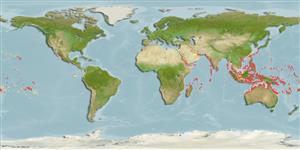Teleostei (teleosts) >
Kurtiformes (Nurseryfishes, cardinalfishes.) >
Apogonidae (Cardinalfishes) > Apogoninae
Etymology: Fowleria: Taken from Fowler, ichthyiologist, 1945 (Ref. 45335).
Eponymy: Henry Weed Fowler (1878–1965) was an American herpetologist, ornithologist, ichthyologist and artist. [...] (Ref. 128868), visit book page.
More on author: Valenciennes.
Issue
Junior synonym Apogonichthys polystigma Bleeker, 1854 is considered to be valid as Fowleria polystigma in Ref. 96888.
Environment: milieu / climate zone / depth range / distribution range
Ecology
Marine; reef-associated; depth range 0 - 27 m (Ref. 11441). Tropical; 30°N - 24°S
Indo-West Pacific: Red Sea, Oman, Persian Gulf, Kenya, Maldives; east to the Samoa Islands; north to Ryukyu Islands and south to New South Wales (Australia).
Size / Weight / Age
Maturity: Lm ? range ? - ? cm
Max length : 8.0 cm TL male/unsexed; (Ref. 9710)
Dorsal spines (total): 8; Dorsal soft rays (total): 9; Anal spines: 2; Anal soft rays: 8. This species is distinguished by the following characters: D VII + I,9; A II,8; pectoral fin rays 12-14; lateral-line scales 23 (23rd overlapping caudal-fin base), the first 10-13 with tubes; median predorsal scales 4; total gill-rakers 3-4 + 11-13; developed rakers 1+ 5-6; rear edge of preopercle ridge smooth, the lower edge membranous and crenulate; body depth 2.5-2.95, head length 2.3-2.4 in SL; snout length 4.2-4.5, eye diameter 3.1-3.8, interorbital width 5.8-7.05, and upper-jaw length 1.9-2.0, all in head length; jaws and vomer with villiform teeth in bands, none on palatines; caudal-peduncle depth 1.15-1.45 in peduncle length, and peduncle length 4.2-4.7 in SL; round shaped caudal fin (Ref. 50837).
Found in coral reefs and seagrass beds of inner bays and shallow lagoons (Ref. 1602); also in dead reef and rubble (Ref. 48635). Nocturnal species (Ref. 7300). Solitary or in small groups (Ref 90102).
Life cycle and mating behavior
Maturity | Reproduction | Spawning | Eggs | Fecundity | Larvae
CDistinct pairing during courtship and spawning (Ref. 205).
Gon, O. and J.E. Randall, 2003. A review of the cardinalfishes (Perciformes: Apogonidae) of the Rea Sea. Smithiana Bull. 1:1-47. (Ref. 50837)
IUCN Red List Status (Ref. 130435: Version 2024-2)
Threat to humans
Harmless
Human uses
Tools
Special reports
Download XML
Internet sources
Estimates based on models
Preferred temperature (Ref.
123201): 25.3 - 29.3, mean 28.4 °C (based on 3220 cells).
Phylogenetic diversity index (Ref.
82804): PD
50 = 0.5078 [Uniqueness, from 0.5 = low to 2.0 = high].
Bayesian length-weight: a=0.01445 (0.00860 - 0.02429), b=3.13 (2.99 - 3.27), in cm total length, based on LWR estimates for this species & (Sub)family-body (Ref.
93245).
Trophic level (Ref.
69278): 3.5 ±0.50 se; based on food items.
Resilience (Ref.
120179): High, minimum population doubling time less than 15 months (Preliminary K or Fecundity.).
Fishing Vulnerability (Ref.
59153): Low vulnerability (10 of 100).
Nutrients (Ref.
124155): Calcium = 178 [87, 315] mg/100g; Iron = 1.13 [0.63, 2.05] mg/100g; Protein = 18.6 [17.3, 19.8] %; Omega3 = 0.129 [0.066, 0.250] g/100g; Selenium = 33.9 [15.6, 71.1] μg/100g; VitaminA = 54.6 [14.8, 203.3] μg/100g; Zinc = 1.99 [1.26, 3.06] mg/100g (wet weight);
